 ] Title Type Year
] Title Type Year V Jornadas de Ingenería Telemática (JITEL’05), pp. 335-343, Septiembre, 2005.
Abstract
The design and development of security infrastructures and protocols for Wireless Sensor Networks is a difficult task, due to several factors like the constraints of the sensor nodes and the public nature of the communication channels. The intrinsic features of these networks create numerous security problems. In this paper, we analyze and put into perspective those problems.
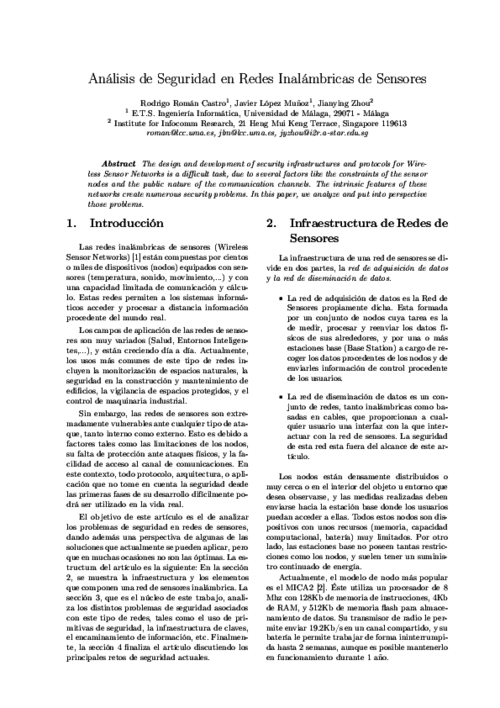
Wireless Communications and Mobile Computing, vol. 11, Wiley, pp. 267-276, 2011. DOI
Abstract
The wireless sensor networks (WSN) paradigm is especially vulnerable against external and internal attacks. Therefore, it is necessary to develop security mechanisms and protocols to protect them. These mechanisms must become an integral part of the software architecture and network stack of a sensor node. A question that remains is how to achieve this integration. In this paper we check how both academic and industrial solutions tackle this issue, and we present the concept of a transversal layer, where all the different security mechanisms could be contained. This way, all the elements of the architecture can interact with the security mechanisms, and the security mechanisms can have a holistic point of view of the whole architecture. We discuss the advantages of this approach, and also present how the transversal layer concept was applied to a real middleware architecture.
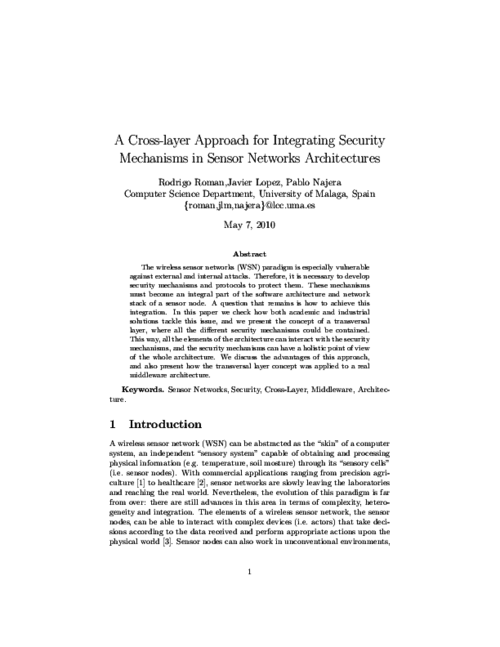
1st International Conference on Autonomic Computing and Communication Systems (Autonomics’07), ICST, October, 2007.
Abstract
Research on trust management systems for wireless sensor networks is still at a very early stage and few works have done so far. It seems that for those works which deal with the topic general features of how these systems should be are not clearly identified. In this paper we try to identify the main features that a trust management system should have and justify their importance for future developments.
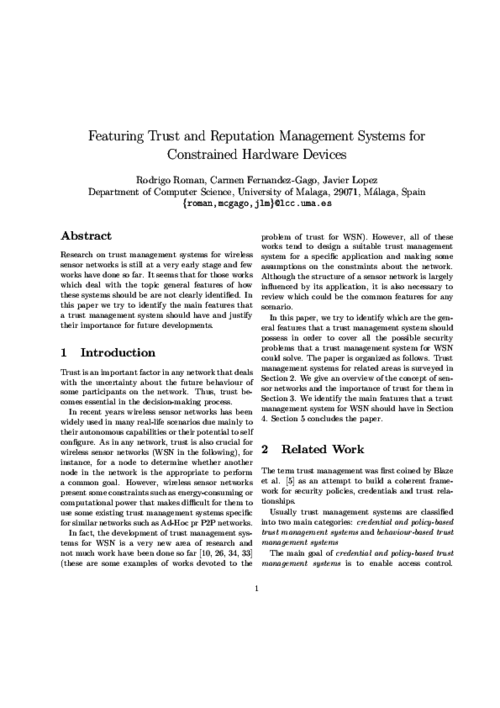
3rd CompanionAble Workshop - Future Internet of People, Things and Services (IoPTS) eco-Systems, xxxx, pp. xxxx, December, 2009.
Abstract
Wireless sensor networks are considered as an integral part of the Internet of Things paradigm. Not only they provide a virtual presence to elements of the real world, but also allow any computationalsystem to know about the physical state of those elements thanks to the use of embedded sensors. In order to belong to the Internet of Things, the elements of a sensor network can implement Internet protocols and services such as the TCP/IP stack and web services. Still, a question that must be raised at this point of time is whether all sensor network applications should be completely integrated into the Internet or not. The purpose of this paper is to analyze this question, reviewing the challenges and security requirements of Internet-enabled sensor networks.
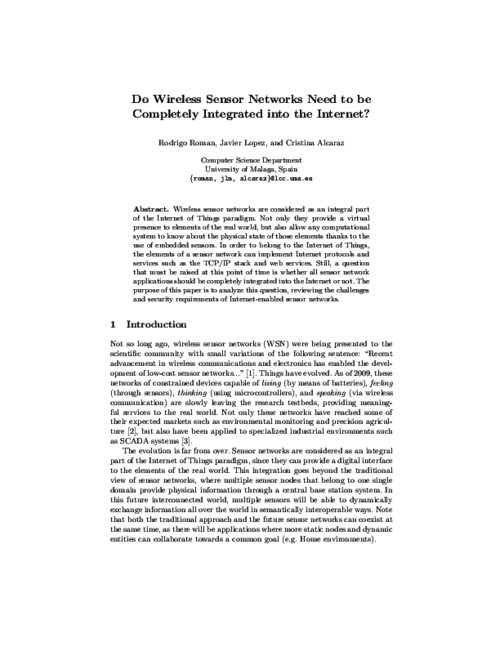
IEEE Consumer Communications & Networking Conference (CCNC 2006), IEEE, pp. 640-644, January, 2006. DOI
Abstract
The research of Intrusion Detection Systems (IDS) is a mature area in wired networks, and has also attracted many attentions in wireless ad hoc networks recently. Nevertheless, there is no previous work reported in the literature about IDS architectures in wireless sensor networks. In this paper, we discuss the general guidelines for applying IDS to static sensor networks, and introduce a novel technique to optimally watch over the communications of the sensors’ neighborhood on certain scenarios.
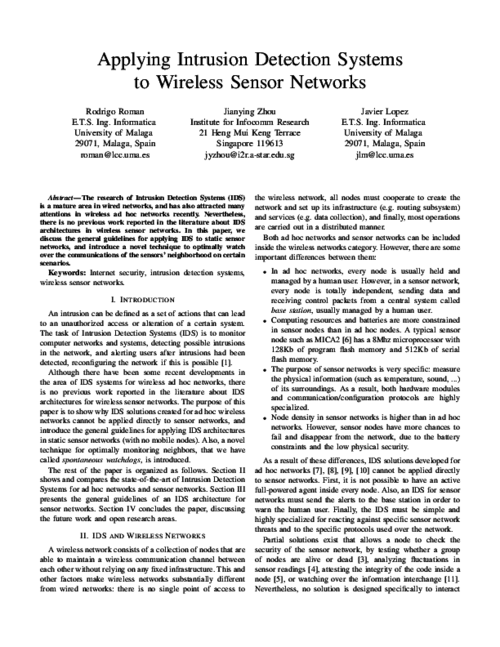
Computers & Electrical Engineering, vol. 37, Elsevier, pp. 147-159, Mar 2011. DOI
Abstract
If a wireless sensor network (WSN) is to be completely integrated into the Internet as part of the Internet of Things (IoT), it is necessary to consider various security challenges, such as the creation of a secure channel between an Internet host and a sensor node. In order to create such a channel, it is necessary to provide key management mechanisms that allow two remote devices to negotiate certain security credentials (e.g. secret keys) that will be used to protect the information flow. In this paper we will analyse not only the applicability of existing mechanisms such as public key cryptography and pre-shared keys for sensor nodes in the IoT context, but also the applicability of those link-layer oriented key management systems (KMS) whose original purpose is to provide shared keys for sensor nodes belonging to the same WSN.
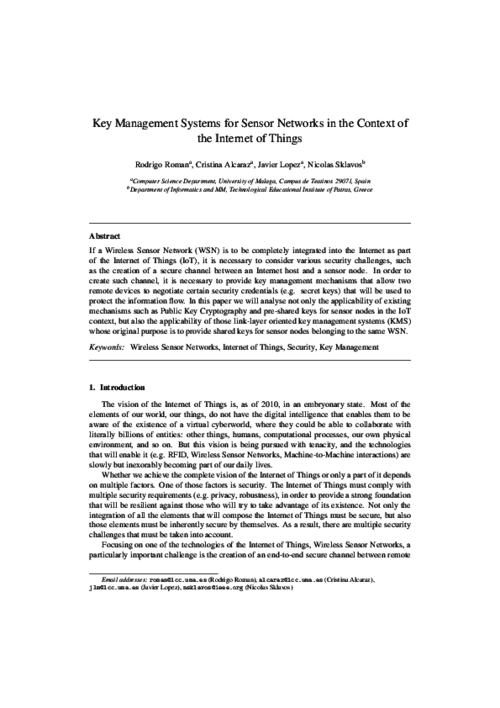
Wireless Sensor Network Security, J. Lopez, and J. Zhou Eds., IOS Press, 2008.
Abstract
Security has been proven a crucial factor in the provision of data services and especially in the computer-related environments. While wired and wireless networks come to all sectors of everyday life, security tries to satisfy the growing needs for confidentiality, integrity and non-repudiation. There are many instances of security primitives and each one of them has different requirements in terms of processing power, word size, etc. Therefore, it is important to review the functionality of the less resource-demanding encryption algorithms in order to analyze their theoretical suitability to the existent sensor node hardware. Still, the constraints inherent to the sensor nodes advise against the total dependence on software-based implementations, even more in the case of expensive primitives.
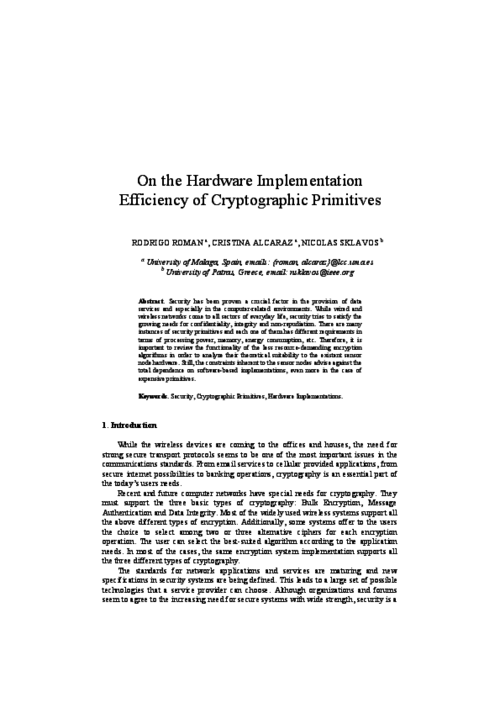
Internet Research, vol. 19, no. 2, Emerald, pp. 246-259, Mar 2009. DOI
Abstract
Purpose: This paper aims to analyze the security issues that arise when integrating wireless sensor networks (WSN) and the internet. Also, it seeks to review whether existing technology mechanisms are suitable and can be applied in this context.
Design/methodology/approach: The paper considers the possible approaches that can be used to connect a WSN with the internet, and analyzes the security of their interactions.
Findings: By providing the services of the network through a front-end proxy, a sensor network and the internet can interact securely. There are other challenges to be solved if the sensor nodes are integrated into the internet infrastructure, although there exists interesting advances on his matter.
Research limitations and implications: The complete integration of sensor networks and the internet still remains as an open issue.
Practical implications: With the current state of the art, it is possible to develop a secure sensor network that can provide its services to internet hosts with certain security properties.
Originality/value: The paper studies the interactions between sensor networks and the internet from the point of view of security. It identifies both solutions and research challenges.
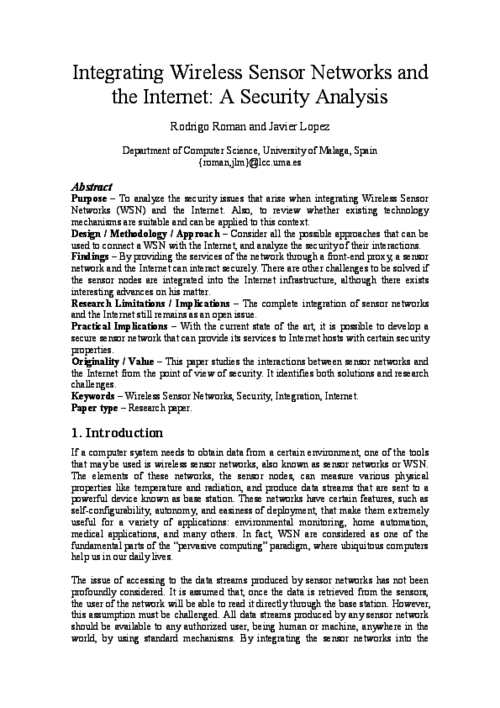
Information Security Technical Report, vol. 12, no. 1, Elsevier, pp. 24-31, 2007. DOI
Abstract
Critical Infrastructures, such as energy, banking, and transport, are an essential pillar to the well-being of the national and international economy, security and quality of life. These infrastructures are dependent on a spectrum of highly interconnected information infrastructures for their smooth, reliable and continuous operation. The field of protecting such Critical Information Infrastructures, or CIIP, faces numerous challenges, such as managing the secure interaction between peers, assuring the resilience and robustness of the overall system, and deploying warning and alert systems, amongst others. In this tapestry of CIIP, Wireless Sensor Networks can be used as an invaluable tool due to their intelligent distributed control capabilities, alongside with their capability to work under severe conditions. In this paper, we justify why Wireless Sensor Networks technology is suitable for providing security for these scenarios, describing both their advantages and research issues and their role in the overall scheme of protecting the Critical Information Infrastructures.

5th International Symposium on Security and Multimodality in Pervasive Environments (SMPE’11), IEEE, March, 2011. DOI
Abstract
Key Management Schemes (KMS) are a very important security mechanism for Wireless Sensor Networks (WSN), as they are used to manage the credentials (i.e. secret keys) that are needed by the security primitives. There is a large number of available KMS protocols in the literature, but it is not clear what should network designers do to choose the most suitable protocol for the needs of their applications. In this paper, we consider that given a certain set of application requirements, the network designer can check which properties comply with those requirements and select the KMS protocols that contains those particular properties. Therefore, we study the relationship between requirements and properties, and we provide a web tool, the SenseKey tool, that can be used to automatically obtain an optimal set of KMS protocols.
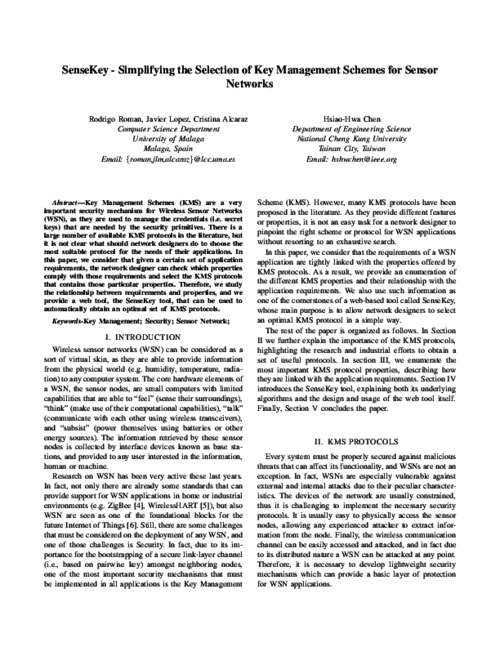
IEEE Communications Magazine, vol. 46, no. 4, IEEE, pp. 102-107, April, 2008. DOI
Abstract
A wireless sensor network should be able to operate for long periods of time with little or no external management. There is a requirement for this autonomy: the sensor nodes must be able to configure themselves in the presence of adverse situations. Therefore, the nodes should make use of situation awareness mechanisms to determine the existence of abnormal events in their surroundings. This work approaches the problem by considering the possible abnormal events as diseases, thus making it possible to diagnose them through their symptoms, namely, their side effects. Considering these awareness mechanisms as a foundation for high-level monitoring services, this article also shows how these mechanisms are included in the blueprint of an intrusion detection system.
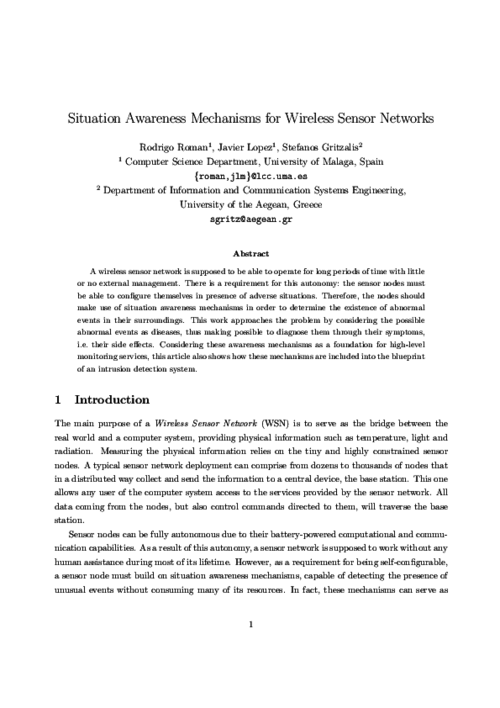
Computational Science and Its Applications (ICCSA’05), LNCS 3482, Springer, pp. 681-690, May, 2005. DOI
Abstract
Wireless Sensor Networks are extremely vulnerable against any kind of internal or external attacks, due to several factors such as resource-constrained nodes and lack of tamper-resistant packages. As a result, security must be an important factor to have in mind when designing the infrastructure and protocols of sensor networks. In this paper we survey the state-of-the-art security issues in sensor networks and highlight the open areas of research.security issues in sensor networks and highlight the open areas of research.
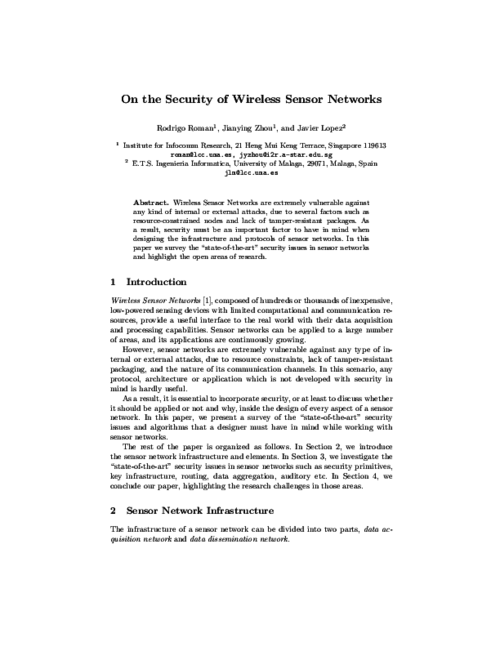
Mobile Networks and Applications, vol. 12, no. 4, Springer, pp. 231-244, August, 2007. DOI
Abstract
In a wireless sensor network environment, a sensor node is extremely constrained in terms of hardware due to factors such as maximizing lifetime and minimizing physical size and overall cost. Nevertheless, these nodes must be able to run cryptographic operations based on primitives such as hash functions, symmetric encryption and public key cryptography in order to allow the creation of secure services. Our objective in this paper is to survey how the existing research-based and commercial-based sensor nodes are suitable for this purpose, analyzing how the hardware can influence the provision of the primitives and how software implementations tackles the task of implementing instances of those primitives. As a result, it will be possible to evaluate the influence of provision of security in the protocols and applications/scenarios where sensors can be used.
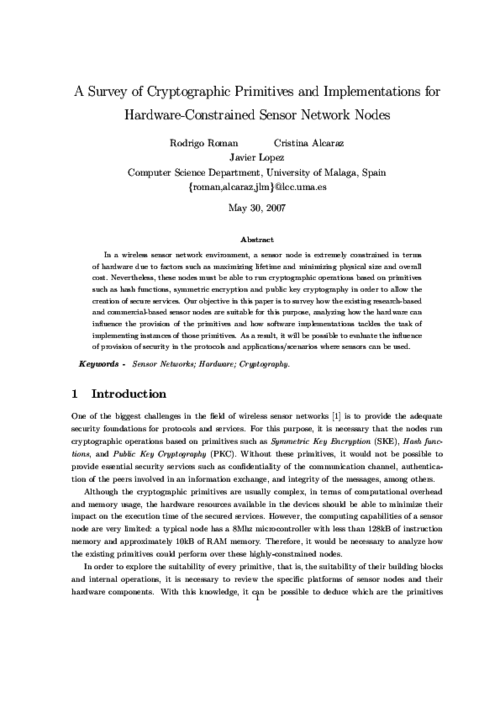
5th IEEE International Conference on Mobile Ad Hoc and Sensor Systems (MASS’08), IEEE, pp. 796-801, September, 2008. DOI
Abstract
An out-of-band (OoB) channel can be defined as an extra channel, different from the main wireless channel, that has additional security properties. They are specially suitable for protecting spontaneous interactions and exchanging sensitive data between previously unknown devices. Due to the vulnerable nature of wireless sensor networks (WSN), these kind of channels might be useful for protecting certain sensor network operations. In this paper we analyze the applicability of out-of-band channels to wireless sensor networks, and specify why an optical channel should be a good candidate for implementing an extra channel in sensor nodes. Also, we analyze how the existing security threats may affect this type of channel. Finally, the suitability and usability of optical channels for sensor networks is demonstrated by means of a prototype.
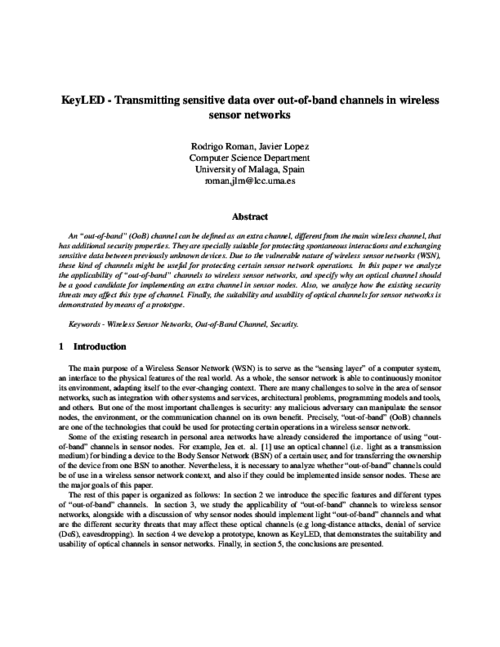
Simposio sobre Computación Ubicua e Inteligencia Ambiental (UCAmI’05), pp. 113-120, September, 2005.
Abstract
Los sistemas de detección de intrusiones (IDS) son una herramienta imprescindible de seguridad a la hora de proteger una red. Recientemente se han investigado y desarrollado arquitecturas de IDS para redes inalámbricas, en concreto para redes "Ad Hoc". No obstante, no existe un trabajo previo que desarrolle una arquitectura de IDS para una red de sensores. En este artículo, analizamos porque los sistemas IDS de redes "Ad Hoc" no pueden aplicarse a redes de sensores, e introducimos una arquitectura de IDS para redes de sensores que incorpora una nueva técnica para vigilar las comunicaciones de la red en ciertos escenarios.
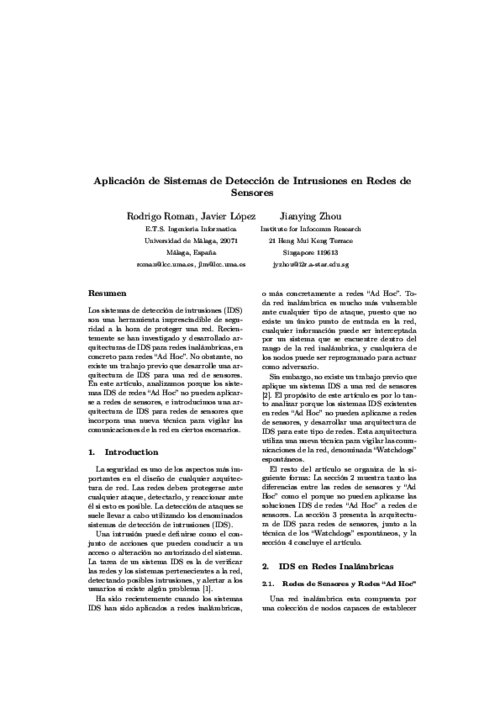
European PKI Workshop: Theory and Practice (EuroPKI’07), LNCS 4582, Springer, pp. 313-320, June, 2007. DOI
Abstract
Wireless Sensor Networks (WSN) are becoming a key technology in the support of pervasive and ubiquitous services. The previous notion of PKC is too expensive for WSN has changed partially due to the existence of new hardware and software prototypes based on Elliptic Curve Cryptography and other PKC primitives. Then, it is necessary to analyze whether it is both feasible and convenient to have a Public Key Infrastructure for sensor networks that would allow the creation of PKC-based services like Digital Signatures.
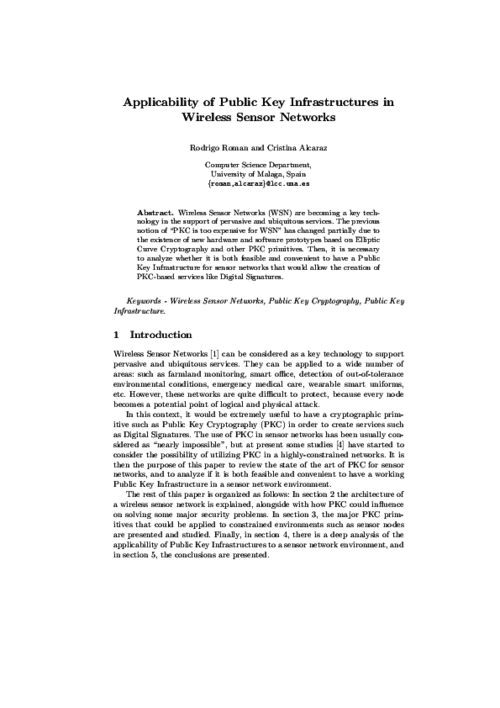
IEEE Computer, vol. 44, no. 9, IEEE, pp. 51 -58, Sept 2011. DOI
Abstract
This paper presents security of Internet of things. In the Internet of Things vision, every physical object has a virtual component that can produce and consume services Such extreme interconnection will bring unprecedented convenience and economy, but it will also require novel approaches to ensure its safe and ethical use. The Internet and its users are already under continual attack, and a growing economy-replete with business models that undermine the Internet’s ethical use-is fully focused on exploiting the current version’s foundational weaknesses.
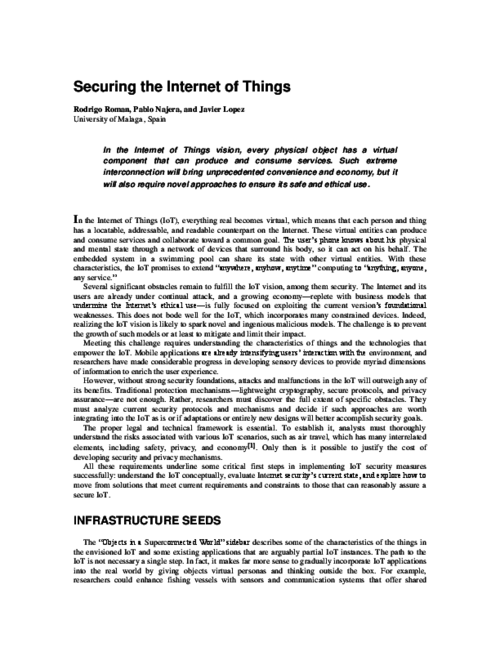
Security and Privacy in Mobile and Wireless Networking, S. Gritzalis, T. Karygiannis, and C. Skianis Eds., Troubador Publishing Ltd, pp. 105-128, 2009.
Abstract
The concept of trust has become very relevant in the late years as a consequence of the growth of fields such as internet transactions or electronic commerce. In general, trust has become of paramount importance for any kind of distributed networks, such as wireless sensor networks (WSN in the following). In this chapter of the book, we try to give a general overview of the state of the art on trust management systems for WSN and also try to identify the main features of the architectures of these trust management systems.
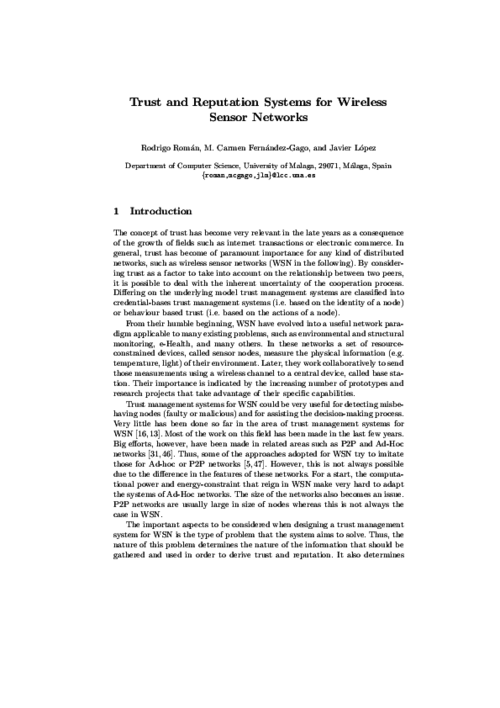
XI Jornadas de Ingeniería Telemática (JITEL 2013), J. E. Díaz Verdejo, J. Navarro Ortiz, and J. J. Ramos Muñoz Eds., Asociación de Telemática, pp. 481-486, Oct 2013.
Abstract
La estación base es el elemento más importante en un red de sensores y, por tanto, es necesario evitar que un atacante pueda hacerse con el control de este valioso dispositivo. Para ello, el atacante puede valerse tanto de técnicas de análisis de tráfico como de la captura de nodos. En este trabajo presentamos un esquema que consta de dos fases, la primera está dedicada a homogeneizar los patrones de tráfico y la segunda encargada de perturbar las tablas de rutas de los nodos. Ambas fases permiten mantener a la estación base fuera del alcance del atacante con un coste computacional insignificante y un consumo energético moderado. La validez de nuestro esquema ha sido validada analíticamente y a través de numerosas simulaciones.
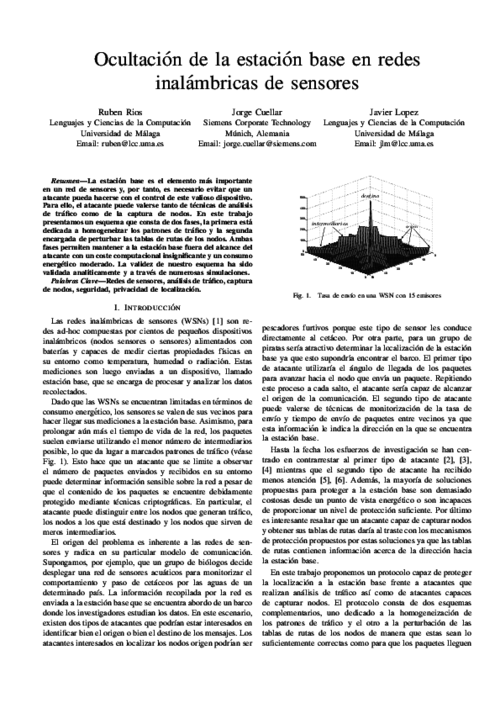
Information Sciences, vol. 321, Elsevier, pp. 205 - 223, 07/2015. DOI
Abstract
Wireless sensor networks (WSNs) are continually exposed to many types of attacks. Among these, the attacks targeted at the base station are the most devastating ones since this essential device processes and analyses all traffic generated in the network. Moreover, this feature can be exploited by a passive adversary to determine its location based on traffic analysis. This receiver-location privacy problem can be reduced by altering the traffic pattern of the network but the adversary may still be able to reach the base station if he gains access to the routing tables of a number of sensor nodes. In this paper we present HISP-NC (Homogenous Injection for Sink Privacy with Node Compromise protection), a receiver-location privacy solution that consists of two complementary schemes which protect the location of the base station in the presence of traffic analysis and node compromise attacks. The HISP-NC data transmission protocol prevents traffic analysis by probabilistically hiding the flow of real traffic with moderate amounts of fake traffic. Moreover, HISP-NC includes a perturbation mechanism that modifies the routing tables of the nodes to introduce some level of uncertainty in attackers capable of retrieving the routing information from the nodes. Our scheme is validated both analytically and experimentally through extensive simulations.
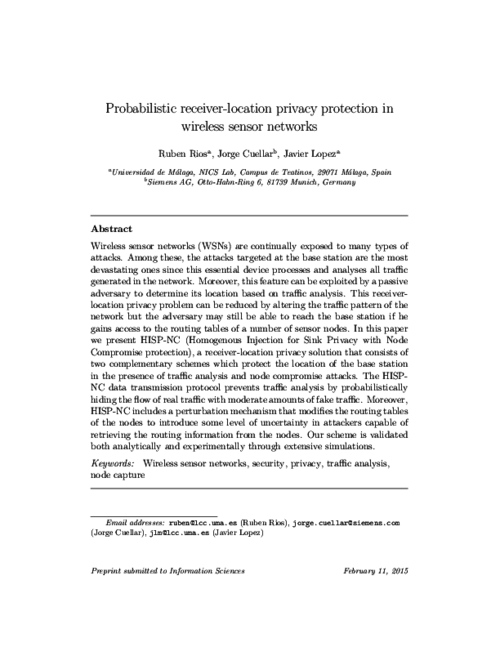
The Computer Journal, vol. 54, Oxford University Press, pp. 1603-1615, Sept 2011. DOI
Abstract
The source-location privacy problem in Wireless Sensor Networks has been traditionally tackled by the creation of random routes for every packet transmitted from the source nodes to the base station. These schemes provide a considerable protection level at a high cost in terms of message delivery time and energy consumption. This overhead is due to the fact that the data routing process is done in a blind way, without knowledge about the location of the attacker. In this work we propose the Context-Aware Location Privacy (CALP) approach, which takes advantage of the ability of sensor nodes to perceive the presence of a mobile adversary in their vicinity in order to transmit data packets in a more energy-efficient and privacy-preserving manner. In particular, we apply the concepts of CALP to the development of a shortest-path CALP routing algorithm. A permissive and a strict version of the protocol are studied for different adversarial models and the proposed schemes are evaluated through simulation experiments in terms of privacy protection and energy consumption. Finally, we present the conclusions of the paper as well as possible extensions of this work.
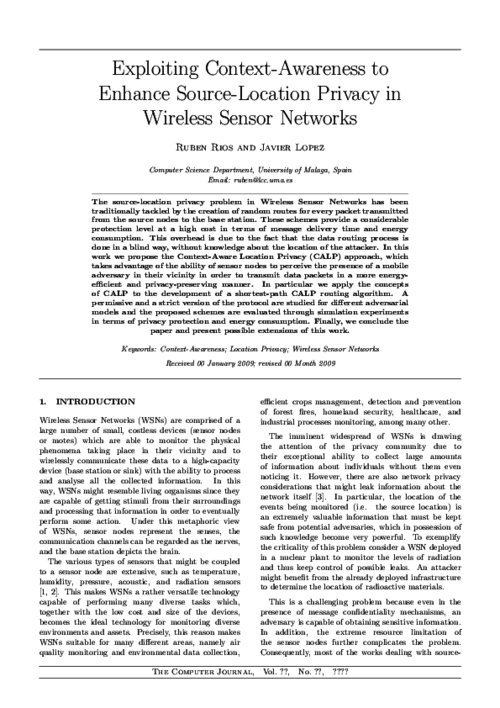
Foundations of Security Analysis and Design VII, vol. 8604, no. LNCS, Springer, pp. 244-282, 2014. DOI
Abstract
Privacy preservation is gaining popularity in Wireless Sensor Network (WSNs) due to its adoption in everyday scenarios. There are a number of research papers in this area many of which concentrate on the location privacy problem. In this paper we review and categorise these solutions based on the information available to the adversary and his capabilities. But first we analyse whether traditional anonymous communication systems conform to the original requirements of location privacy in sensor networks. Finally, we present and discuss a number of challenges and future trends that demand further attention from the research community.

17th European Symposium on Research in Computer Security (ESORICS 2012), S. Foresti, M. Yung, and F. Martinelli Eds., LNCS 7459, Springer, pp. 163-180, Sep 2012. DOI
Abstract
The singular communication model in wireless sensor networks (WSNs) originate pronounced traffic patterns that allow a local observer to deduce the location of the base station, which must be kept secret for both strategical and security reasons. In this work we present a new receiver-location privacy solution called HISP (Homogenous Injection for Sink Privacy). Our scheme is based on the idea of hiding the flow of real traffic by carefully injecting fake traffic to homogenize the transmissions from a node to its neighbors. This process is guided by a lightweight probabilistic approach ensuring that the adversary cannot decide with sufficient precision in which direction to move while maintaining a moderate amount of fake traffic. Our system is both validated analytically and experimentally through simulations.
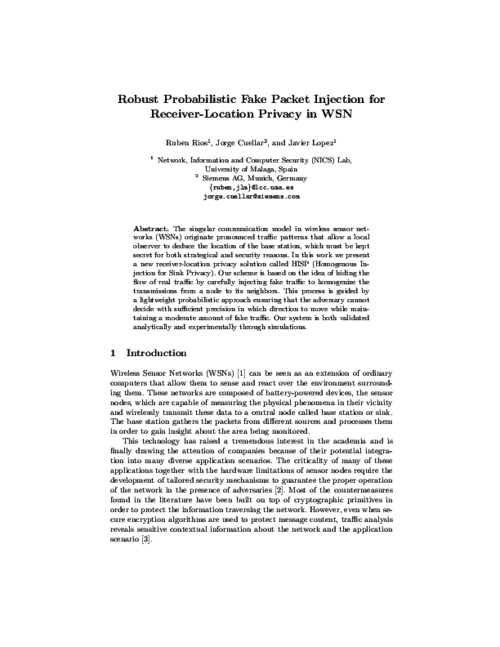
32nd International Conference on ICT Systems Security and Privacy Protection (IFIP SEC 2017), S. De Capitan di Vimercati, and F. Martinelli Eds., IFIP Advances in Information and Communication Technology (AICT) 502, Springer, pp. 141–154, 05/2017. DOI
Abstract
The Internet of Things (IoT) promises to revolutionize the way we interact with the physical world. Even though this paradigm is still far from being completely realized, there already exist Sensing-as-a-Service (S2aaS) platforms that allow users to query for IoT data. While this model offers tremendous benefits, it also entails increasingly challenging privacy issues. In this paper, we concentrate on the protection of user privacy when querying sensing devices through a semi-trusted S2aaS platform. In particular, we build on techniques inspired by proxy re-encryption and k-anonymity to tackle two intertwined problems, namely query privacy and query confidentiality. The feasibility of our solution is validated both analytically and empirically.
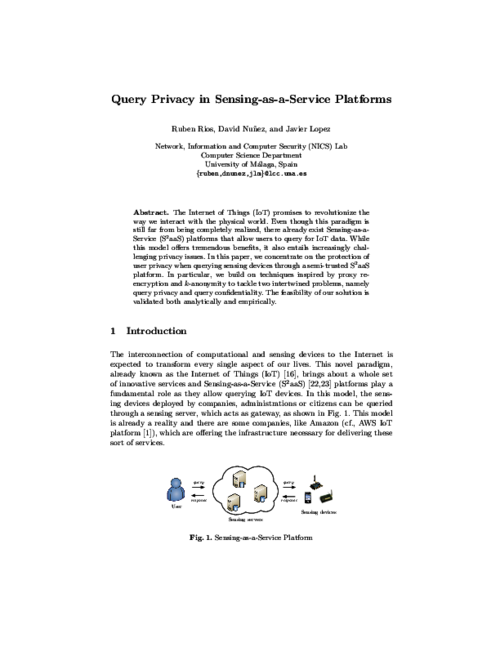
XII Reunión Española sobre Criptología y Seguridad de la Información (RECSI 2012), U.. Zurutuza, R.. Uribeetxeberria, and I.. Arenaza-Nuño Eds., pp. 309-314, Sep 2012.
Abstract
Los patrones de tráfico característicos de las redes inalámbricas de sensores (WSNs) dan lugar al problema de la privacidad de localización. De manera similar, el tráfico de los usuarios en Internet revela información sensible que puede ser protegida mediante sistemas de comunicación anónima (ACS). Por ello, este trabajo analiza la posibilidad de adaptar las soluciones de anonimato tradicionales al problema particular de las redes de sensores. Hasta el momento estas soluciones habían sido rechazadas sin un análisis riguroso, argumentando simplemente que eran demasiado exigentes computacionalmente para los nodos sensores. Nuestros resultados demuestran que, en general, algunos ACS no cumplen los requisitos de privacidad necesarios en WSNs mientras que otros, que si los cumplen, se valen de una cantidad de recursos que superan la capacidad de los sensores.

4th International Symposium of Ubiquitous Computing and Ambient Intelligence (UCAmI’10), L. Fuentes, N. Gámez, and J. Bravo Eds., IBERGARCETA PUBLICACIONES, S.L., pp. 29 - 38, Sept., 2010.
Abstract
Wireless Sensor Networks are considered to be one of the cornerstones of Ambient Intelligence since they can be used in countless applications, where sensors are unobtrusively embedded into the environment to perform operations like monitoring, tracking and reporting. In such scenarios, privacy issues must be carefully considered since the mere observation of the network operation might reveal great amounts of private information to unauthorised parties. One of the problems that is gaining more attention in the realm of privacy, is the location privacy problem, which aims to prevent an attacker from obtaining the location of specific nodes of interest to him. In this paper we provide a general overview of the proposed solutions to counter this threat. Finally, we will also discuss some open challenges and future directions of research for a convenient management of privacy issues in smart environments.
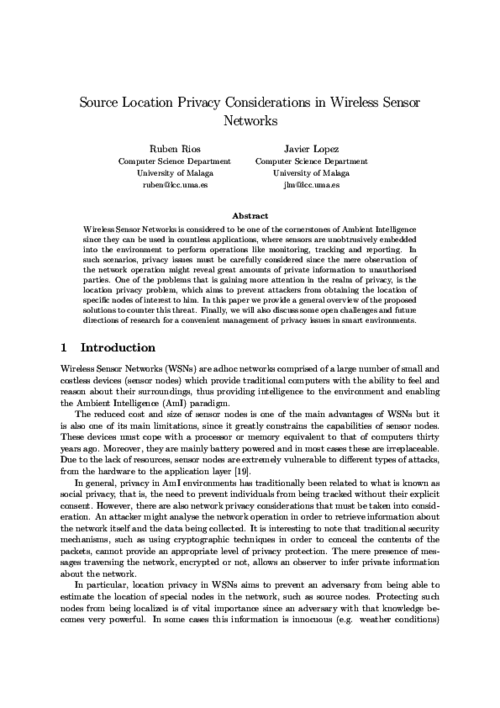
|
"Location Privacy in Wireless Sensor Networks", CRC Series in Security, Privacy and Trust, Taylor & Francis, 2016. 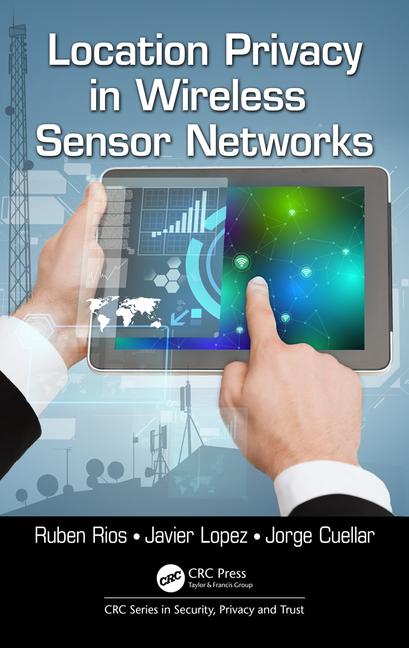 |  |
IET Communications, vol. 5, Institution of Engineering and Technology, pp. 2518 - 2532, Nov 2011. DOI
Abstract
Extensive work has been done on the protection of Wireless Sensor Networks (WSNs) from the hardware to the application layer. However, only recently, the privacy preservation problem has drawn the attention of the research community because of its challenging nature. This problem is exacerbated in the domain of WSNs due to the extreme resource limitation of sensor nodes. In this paper we focus on the location privacy problem in WSNs, which allows an adversary to determine the location of nodes of interest to him. We provide a taxonomy of solutions based on the power of the adversary and the main techniques proposed by the various solutions. In addition, we describe and analyse the advantages and disadvantages of different approaches. Finally, we discuss some open challenges and future directions of research.
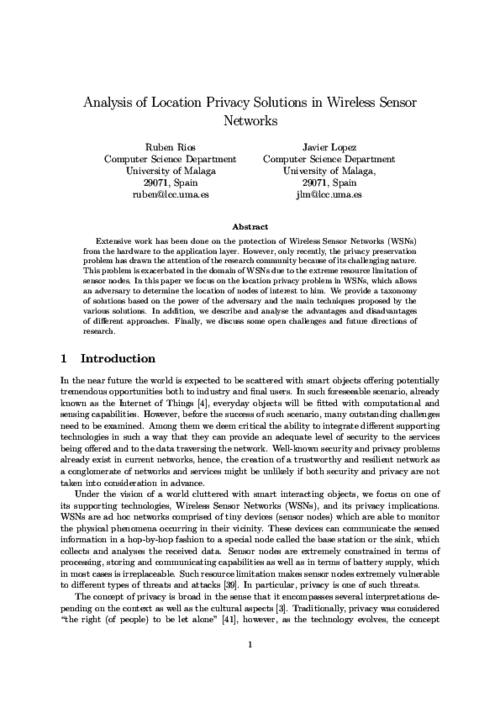
IEEE Systems Journal, vol. 7, no. 2, IEEE Systems Council, pp. 298 - 310, Jun 2013. DOI
Abstract
Anonymous communication systems have been extensively studied by the research community to prevent the disclosure of sensitive information from the analysis of individuals’ traffic patterns. Many remarkable solutions have been developed in this area, most of which have proven to be effective in the protection of user privacy against different types of attacks. Recently, the privacy preservation problem has also been considered in the realm of wireless sensor networks (WSNs) due to their imminent adoption in real-world scenarios. A special challenge that arises from the analysis of the flow of sensor nodes’ communications is the location privacy problem. In this work we concentrate on analyzing the suitability of traditional anonymous communication systems originally designed for the Internet to the original scenario of sensor networks. The results show that, in most cases, traditional solutions do not provide the adequate protection means for the particular problem of location privacy, while other solutions are too resource-consuming for the restricted capabilities of sensor nodes.
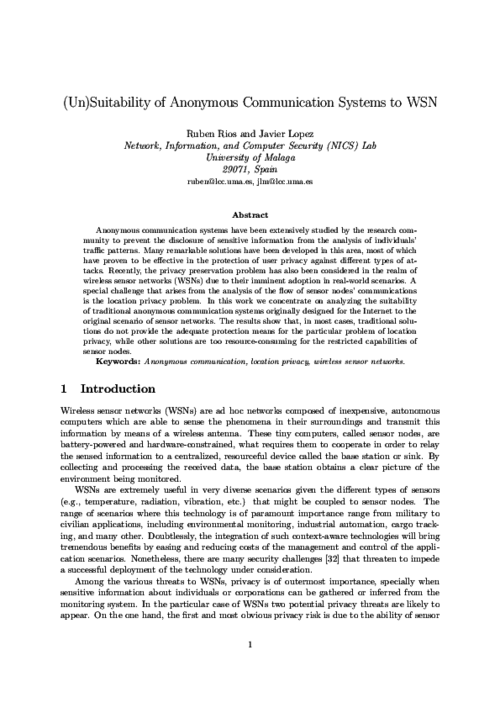
IX Jornadas de Ingeniería Telemática (JITEL’10), Y. Dimitriadis, and M. Jesús Ver Pérez Eds., pp. 237 - 244, Sept., 2010.
Abstract
Las aplicaciones basadas en localización proporcionan a los usuarios servicios personalizados dependiendo de su ubicación. Las estimaciones prevén que estos servicios se extenderán enormemente en los próximos años reportando grandes beneficios tanto a la industria como a los usuarios finales. Sin embargo, para que estos avances sean posibles se hace necesario analizar en profundidad las distintas implicaciones de seguridad y privacidad que la utilización de tales servicios pueden traer consigo a los usuarios. En este trabajo proponemos un sistema de localización que da soporte a la provisión de servicios basados en localización para entornos indoor y que se fundamenta en la tecnología de redes de sensores inalámbricos. En este esquema hemos tenido en cuenta diversos aspectos de seguridad y privacidad, prestando especial atención a la limitación extrema de recursos característica de las redes de sensores. Finalmente hemos desarrollado una prueba de concepto para comprobar la viabilidad de nuestro esquema dentro del ámbito del proyecto OSAmI.

XIV Reunión Española sobre Criptología y Seguridad de la Información, pp. 209-213, 10/2016.
Abstract
La Internet de las Cosas (en inglés, Internet of Things (IoT)) es una evolución de la Internet tal y como lo conocemos. Esta nueva versión de Internet incorpora objetos de la vida cotidiana, rompiendo así barrera de los digital y extendiéndose al mundo físico. Estos objetos interactuarán entre sí y con otras entidades tanto de manera local como remota, y estarán dotados de cierta capacidad computacional y sensores para que sean conscientes de lo que ocurre en su entorno. Esto traerá consigo un sinfín de posibilidades y nuevos servicios, pero también dará lugar a nuevos y mayores riesgos de privacidad para los ciudadanos. En este artículo, estudiamos los problemas de privacidad actuales de una de las tecnologías claves para el desarrollo de este prometedor paradigma, las redes de sensores, y analizamos como pueden evolucionar y surgir nuevos riesgos de privacidad al ser completamente integradas en la Internet.
